2011 FISA World Rowing Tour at Lake Biwa, Japan
|
|
|
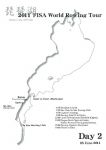
About 40 rowers from overseas rowed around Lake Biwa in Shiga Prefecture, Japan on June 5-11, 2011 for the annual FISA World Rowing Tour held for the first time in Asia. Schedule and map for June 5, the first day of rowing. They started from Otsu.
|
|

June 6, 2011 (Day 3): Rowing from Moriyama to Imazu. They made history by being the largest (around 40) and perhaps only group from overseas to row completely around Lake Biwa.
|
|
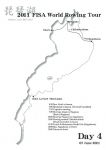
June 7, 2011 (Day 4): Rowing from Imazu to Nagahama in northern Lake Biwa. This online gallery shows only 372 photos of the rowing tour mostly taken by Seta Rowing Club members. They show only the highlights of the tour.
|
|
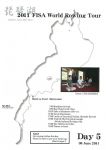
June 8, 2011 (Day 5): Day trip to Enryakuji temple (No rowing). Photos here are shown for display purposes, not really for downloading. Rowers will receive a disc of high-resolution photos.
|
|
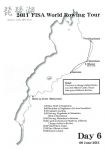
June 9, 2011 (Day 6): Rowing from Nagahama to Hikone (Satsuma Beach).
|
|
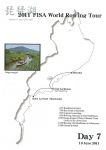
June 10, 2011 (Day 7): Rowing from Hikone (Satsuma Beach) to Moriyama. Lake Biwa is Japan's largest lake in Shiga Prefecture. "Biwa" means lute. The lake has a number of unique species such as the Lake Biwa catfish.
|
|
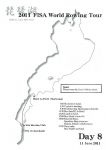
June 11, 2011 (Day 8): Rowing from Moriyama to Otsu (Seta River). Shiga Prefecture is one of Japan's 47 prefectures. A prefecture is similar to a US state like California, Texas, etc.
|
|

T-shirt with "Biwako" written was given to all rowers. "Biwako" means Lake Biwa. Rowing is most common at the southern tip of the lake, along Seta River in the capital city of Otsu. A few rowing clubs row partially around the lake.
|
|

June 4, 2011 (Day 1) started with a reception at LaForet Hotel in Moriyama, Shiga Prefecture.
|
|

Welcome Ceremony at LaForet Hotel in Moriyama. The tour was supposed to have 60 rowers, but many cancelled due to the sensationalized Fukushima radiation scare without understanding that Shiga was unaffected.
|
|

Masaki Unose, tour director and member of the Seta Rowing Club in Otsu, gives a welcome speech. The rowing tour was organized and hosted by the Seta Rowing Club.
|
|

Jens Chr. Kolberg from FISA. Leader of the rowing group. FISA is the Fédération Internationale des Sociétés d'Aviron, the International Rowing Federation which is the governing body for international Rowing.
|
|

Motoki Kyo, chairman of Seta Rowing Club.
|
|

Kanpai! (Cheers)
|
|

Thirty-nine rowers from overseas (12 countries, mainly Europe) and three rowers from Japan participated for a total of 42. The FISA World Rowing Tour has been held since 1971.
|
|

Tea ceremony and koto (Japanese harp) performance.
|
|

Koto lesson.
|
|

Trying the tea.
|
|

Seta Rowng Club members in kimono.
|
|

The back of her kimono obi sash has a design featuring rowing geisha.
|
|
|
|
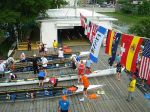
The Seta Rowing Club is in eastern Otsu. It has a two-story clubhouse and an annex for storing more boats. It fronts a small canal connected to the lake.
|
|

Ganbaro Nippon! stickers on oars.
|
|

"Ganbaro" means, "do your best and don't give up." This is the slogan for people affected by the earthquake and tsunami which occurred in northern Japan.
|
|

Ground staff wore bright yellow T-shirts with the Lake Biwa logo on the back.
|
|

Captain's meeting. They wear Chinaman hats.
|
|

Taiko drummers send off the rowers.
|
|
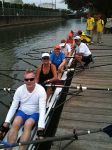
Rowers casting off at Seta Rowing Club.
|
|

Seta Rowing Club front a small canal connected to Lake Biwa.
|
|
|

Omi Ohashi Bridge near Seta Rowing Club. (Not to be confused with a larger Biwako Ohashi Bridge more north.)
|
|
|

Photo taken from Omi Ohashi Bridge.
|
|
|
|

Heading for Ogoto.
|
|
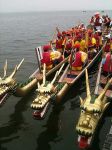
Dragon boat ride at Ogoto. Ogoto is a major hot spring town.
|
|
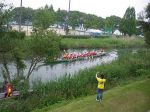
Rowing on dragon boats from Ogoto to Katata.
|
|

Shiga does have dragon boat races. Dragon boats are fun because anybody can row on it.
|
|
|
|
|

Dragon boat drummer.
|
|
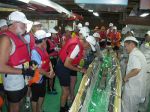
Visit to Kuwano Rowing Boat Factory in Katata.
|
|

Katata is on the west end of Biwako Ohashi Bridge, opposite of Moriyama where the hotel was. The ferris wheel was part of an amusement park which closed over 10 years ago. It has been rusting and abandoned since.
|
|

Rowing to Hotel Laforet beach.
|
|

Landing at the beach in front of Hotel Laforet.
|
|
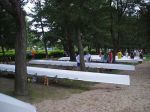
Beach in front of Hotel Laforet.
|
|

Beach in front of Hotel Laforet.
|
|
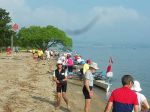
June 6, 2011 (Day 3): Beach in front of Hotel Laforet.
|
|
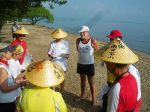
Captain's meeting.
|
|
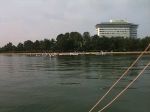
Leaving the beach in front of Hotel Laforet.
|
|

That's Hotel Laforet in the background, where the rowers stayed every night during the rowing tour and commuted to/from the rowing start/end points.
|
|
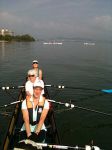
Leaving beach in front of Hotel Laforet.
|
|
|
|
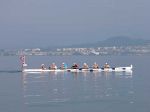
Rowing along western Lake Biwa.
|
|
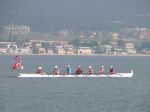
Rowing along western Lake Biwa. The JR Kosei Line is in the background. The Kosei Line runs from Kyoto to Imazu.
|
|
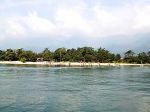
Omi-Maiko Beach, a rest stop.
|
|

Omi-Maiko is Lake Biwa's most famous and popular beach. Well-known for white sands and green pine trees. In summer, people from Kyoto come here to swim and sun bathe.
|
|
|

Omi-Maiko is famous for Japanese pine trees lining the beach.
|
|
|
|

Passing by Shirahige Shrine in Takashima, western Lake Biwa.
|
|
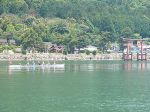
Shirahige Shrine's torii gate in the lake is one of Lake Biwa's best-known landmarks. It faces the shrine on land.
|
|
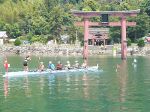
The torii is a smaller version of the much more famous one in Miyajima (Itsukushima Shrine in Hiroshima Prefecture). 白鬚神社
|
|
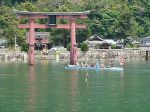
"Shirahige" means white beard, and so people pray here for long life and longevity. The shrine is dedicated to a god named Sarutahiko.
|
|
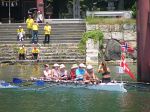
Rowing through the torii. Seta Rowing Club ground crew greet the rowers from land.
|
|
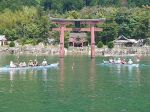
People also pray at the shrine for finding a good marriage partner, conceiving a child, academic excellence (passing college entrance exams), and water/boating safety.
|
|
|
|

A busload of tourists even stopped to gawk at the spectacle of rowers around the torii.
|
|
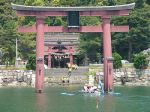
An unusual sight indeed.
|
|
|
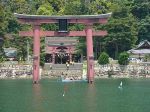
The torii in the water is perfectly aligned with the torii on land and the shrine's main worship hall.
|
|
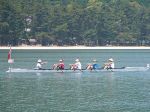
The western shore of Lake Biwa has many white sand beaches.
|
|
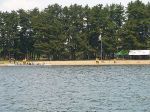
Final stop for the day was here at Shirahama Beach. "Shirahama" means white sand beach.
|
|

Shirahama Beach along the lake's western shore.
|
|
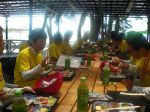
Lunch at Shirahama.
|
|
|

June 7, 2011 (Day 4): Imazu is the birthplace of the Lake Biwa Rowing Song in 1917 when Kyoto University rowers lodged here and sang the new song they had created.
|
|
|
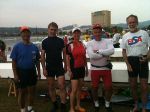
Posing at Imazu, a nice lakeside town. In June, they hold a choir contest for the Lake Biwa Rowing Song. More photos of Imazu here.
|
|

Leaving Imazu.
|
|
|
|

Departing Imazu.
|
|
|
|

The brown building is the Imazu Sun Bridge Hotel.
|
|
|
|
|

The lead boat (normally a fishing boat) leads the way.
|
|
|
|
|
|
|
|
|

Chikubushima island in the background with Mt. Ibuki, Shiga's highest mountain (in Maibara), on the right.
|
|
|
|

Heading for Sugaura, a small lakeside town in northern Lake Biwa.
|
|
|
|
|
|

Heading for Sugaura, a small lakeside village. From Sugaura, there's a scenic road going up the mountains called Oku-Biwako Parkway. Part of the road is visible here.
|
|
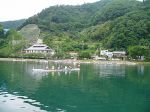
Arriving at Sugaura for a rest stop. Sugaura is one of the best areas of northern Lake Biwa with a nice lakeshore road and trail almost to the tip of the peninsula. It's a quiet and scenic place.
|
|
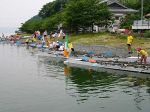
Sugaura
|
|

Rest stop in Sugaura.
|
|
|

Leaving Sugaura.
|
|

Leaving Sugaura.
|
|
|
|
|

Rowing away from Kaizu-Osaki.
|
|
|

Heading for Chikubushima island.
|
|

The rear of Chikubushima island is still recovering from wilted trees caused by tens of thousands of cormorant birds.
|
|

Cormorant birds fly above Chikubushima, their favorite home.
|
|

Cormorant birds (those white specks are the birds) break off tree branches to make nests, and their acidic droppings damage the trees. However, it seems the cormorant population is decreasing and the island is showing more greenery than before.
|
|

The cormorant birds inhabit parts of the island inaccessible to humans. Besides ruining the greenery on the island, they also gobble up the fish in the lake, seriously affecting the local fishermen.
|
|

Front side of Chikubushima is a complex of temples and shrines.
|
|

Chikubushima is home to Hogonji Temple (Shingon Buddhist Sect) first built in 724 as ordered by the Emperor to worship the Goddess Benzaiten. It includes buildings that are National Treasures.
|
|

Chikubushima is also home to Tsukubusuma (Chikubushima) Shrine which is also a National Treasure.
|
|

Passing by Chikubushima Pier. On the island at the center of the photo, there is a light brown, rectangular monument dedicated to the "Lake Biwa Rowing Song" which mentions Chikubushima.
|
|

Too bad the rowers didn't have time to visit the island. It might tire them though as there are a lot of steps to climb.
|
|
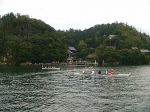
According to legend, two high mountains in northern Shiga argued over who was the highest in Shiga. One of the mountains got so upset by the argument that he drew a sword and sliced off the other mountain's peak...
|
|
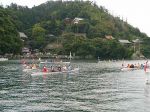
The sliced-off peak flew high in the air and fell into Lake Biwa. It became Chikubushima. And the undisputed highest mountain in Shiga became Mt. Ibuki in Maibara.
|
|
|
|
|

Heading for Nagahama.
|
|
|
|
|
|
|

Trees on a sandbar, a haven for birds.
|
|
|
|
|
|
|
|
|
|
|

Rough waves.
|
|

Although it was during the rainy season, the rowers endured minimal rain and bad weather. The tour went on every day as scheduled. If it were Aug., it would have been really hot and humid.
|
|
|
|
|

Nagahama Port
|
|

Ground crew awaits rowers at Nagahama Port.
|
|

Arriving at Nagahama Port. Nagahama is one of Shiga's major cities and covers northern Shiga almost entirely. Chikubushima is also part of Nagahama.
|
|

Portable boat landing decks (in blue) were used.
|
|

Group photo in Nagahama.
|
|
|
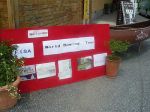
Lunch in Nagahama (Restaurant North Pole).
|
|
|

June 8, 2011 (Day 5): Day trip to Enryakuji temple on Mt. Hie in Otsu. This is the cable car station at Sakamoto, at the foot of Mt. Hie (Hie-zan) in western Shiga.
|
|
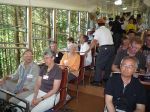
Inside the cable car going up to Enryakuji temple. One of the largest temple complexes in Japan, Enryakuji is the headquarters of the Tendai Buddhist sect atop Mt. Hie in Otsu, Shiga Prefecture.
|
|
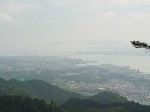
Mt. Hiei affords great views of southern Lake Biwa. Enryakuji was founded by the priest Saicho to protect Kyoto from the demons of the northeast.
|
|
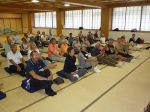
Zazen meditation lesson at Enryakuji temple. Mt. Hie is the birthplace of Japanese Buddhism as many founders of Japanese Buddhist sects once trained on Mt. Hiei.
|
|
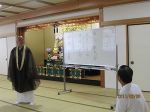
A priest explains the concepts behind the practice of meditating. Enryakuji is also part of a World Heritage Site called ''Historic Monuments of Ancient Kyoto."
|
|

Mt. Hie is on the border between Shiga and Kyoto. The east side of Mt. Hie is in Shiga, while the west side is in Kyoto. Enryakuji is on the east side in Shiga and also accessible from Kyoto.
|
|
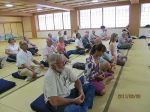
Sitting on the tatami mat for a long period can be trying.
|
|
|
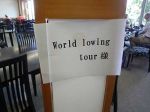
Lunch and a misspelling.
|
|
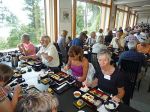
Lunch at Enryakuji.
|
|
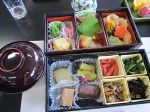
Buddhist cuisine called "shojin ryori" which is vegetarian.
|
|

Chopstick lesson.
|
|
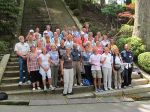
Group photo on the steps going to Monjuro tower.
|
|
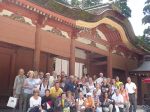
Group in front of Konpon Chudo Hall, a National Treasure and Enryakuji's main worship hall and largest building.
|
|
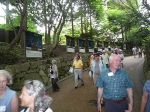
Picture panels telling stories of famous Japanese Buddhist Sect founders such as Honen, Shinran, and Nichiren who trained on Mt. Hiei.
|
|
|

June 9, 2011 (Day 6): Nagahama Port at around 8 am. This was the only day I accompanied the rowers on a motorboat to take pictures and videos.
|
|

Leaving Nagahama Port at around 8:30 am. Photos you see here are only part of the total number of photos I gave to Seta Rowing Club for distribution.
|
|

These blue boat landing decks are portable and were brought here by truck.
|
|
|

Leaving Nagahama.
|
|
|
|

Lead boat
|
|

Rowing past Nagahama Dome, a sports and event complex.
|
|

Rowing off Maibara in northern Shiga. The tall white tower belongs to an elevator manufacturer for testing their elevators. Maibara is best known for Mt. Ibuki and Shiga's one and only shinkansen bullet train station.
|
|
|

Rowing to Hikone.
|
|
|
|
|

Rowing past Hikone View Hotel and the Japan Center for Michigan Universities or JCMU (green roof).
|
|

JCMU is an educational facility for college students mainly from Michigan to study in Japan. Shiga and the US state of Michigan are sister states. Many cities in Shiga have sister-city ties with cities in Michigan.
|
|
|
|

Approaching Matsubara Beach in Hikone.
|
|

Matsubara Beach in Hikone, a rest stop.
|
|
|

Matsubara Beach in Hikone, a rest stop.
|
|
|

In summer, Matsubara Beach is popular with swimmers and a fireworks display offshore sees huge crowds filling the beach.
|
|

Leaving Matsubara Beach in Hikone.
|
|
|
|

Rowing past Hikone Castle atop a hill.
|
|

Heading for Takeshima, a small island about 6.5 km off Hikone.
|
|
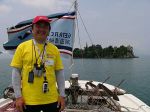
Masaki "Follow Me" Unose on the lead boat going to Takeshima island.
|
|

Takeshima is a small island with only Nichiren Buddhist temple and the priest's family living on the island. Accessible by boat from Hikone, Shiga Prefecture.
|
|

The island is noted for its giant stone monument inscribed with the prayer words "Namu Myo-horenge-kyo" from the Lotus Sutra.
|
|

Takeshima means "Island of Many Views" because it looks dramatically different from different angles.
|
|
|

Approaching Satsuma Beach, the final stop for the day.
|
|

Approaching Satsuma Beach.
|
|

Satsuma Beach in Hikone.
|
|

Hot rowers in a cool Lake Biwa.
|
|

Shabu-shabu lunch in Hikone with Omi beef. People had questions about how to eat the food. Cook the meat, vegetables, and udon noodles in the little shabu-shabu pot of boiling water, then dip into the sauce. One sauce for the meat, another for the udon.
|
|

After lunch, the group visited Hikone Castle and Genkyuen Garden. Hikone Castle is famous for cherry blossoms and Hiko-nyan (see next photo).
|
|

Watching Hiko-nyan, Hikone Castle's official mascot which is wildly popular. He performs daily inside Hikone Castle Museum. He is a white cat with a samurai helmet.
|
|

Steep stairs inside Hikone Castle tower.
|
|
|
|

Top floor of Hikone Castle tower. Hikone Castle's last lord was Ii Naosuke, the Chief Minister of the Tokugawa samurai government. He was the one who agreed to open Japan to the USA in 1858 after Commodore Perry visited.
|
|
|

My video of the the group rowing from Nagahama to Hikone (Satsuma) on June 9, 2011.
|
|

June 10, 2011 (Day 7): Satsuma Beach in Hikone. Someone camped here overnight to watch over the boats.
|
|

Preparing to leave Satsuma Beach.
|
|
|
|

Leaving Satsuma Beach.
|
|
|
|
|
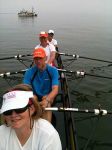
Leaving Satsuma Beach.
|
|

Leaving Satsuma Beach.
|
|
|
|
|
|
|
|
|
|
|

Approaching Isakiji temple.
|
|

Isakiji temple has a 13-meter long plank jutting above the lake in the city of Omi-Hachiman.
|
|
|
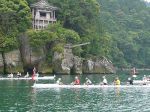
Isakiji temple holds a Buddhist ritual on Aug. 1 where participants jump off the plank into the lake 7 meters below. They do it to wash away bad luck and build up courage.
|
|
|
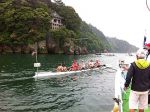
Passing by Isakiji temple.
|
|

Motor boat flying Seta Rowing Club's flag.
|
|
|
|

Rowing past Miyagahama Beach in Omi-Hachiman.
|
|
|
|
|
|

Arriving at the boat landing for the Scenic Water Channel boat ride (Suigo Meguri) in Omi-Hachiman.
|
|
|
|
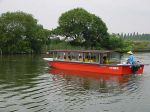
The Scenic Water Channel boat ride uses traditional-looking motorized boats for large groups.
|
|
|

Passengers sit on the floor like in a Japanese room and have lunch as they ride through reed fields in and around Lake Nishinoko in Omi-Hachiman.
|
|
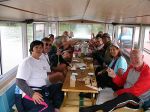
Click on page 2 below to see more photos.
|
|
|
|